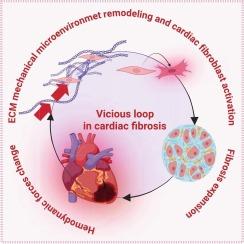心肌纤维化中细胞外基质机械转导的表观遗传调控。
IF 5.6
2区 医学
Q1 PHARMACOLOGY & PHARMACY
引用次数: 0
摘要
心脏成纤维细胞活化和心脏纤维化是一个病理生理修复过程,它对心脏的各种有害刺激作出反应,导致心室舒张顺应性降低,机械转导受损,心律和泵送功能剧烈变化,气血交换受阻。这些变化在一定程度上反映在心脏的机械转导重塑,以及与心脏力学相关的细胞外基质的数量、组成、硬度、血流动力学力、机械敏感信号转导、表观遗传调控等方面的变化。心脏成纤维细胞可以合成和分泌细胞外基质,并通过多种表面受体和复合物接受细胞外基质的信号,这在机械转导中起着重要的作用。此外,微环境的力学特性对于确定纤维化反应和心脏性能至关重要。本文综述了心脏的多尺度力学变化,并详细介绍了力学分子因素如何影响心脏力学转导和纤维化的发展。最后,我们讨论并考虑机械靶向药物如何影响心脏中的这些机械转导事件,希望为未来治疗相应的人体压力过载诱导的心脏纤维化提供见解。本文章由计算机程序翻译,如有差异,请以英文原文为准。

Epigenetic regulation of extracellular matrix mechanotransduction in cardiac fibrosis
Cardiac fibroblasts activation and cardiac fibrosis is a pathophysiological repair process that respond to various detrimental stimuli in the heart, leading to reduced ventricular diastolic compliance, impaired mechanotransduction, drastic changes in heart rhythm and pumping function, and obstruction of gas-blood exchange. To some extent, these changes are reflected in the cardiac mechanotransduction remodeling, as well as changes in the quantity, composition, and hardness of extracellular matrix, hemodynamic forces, mechanosensitive signal transduction, and epigenetic regulation related to cardiac mechanics. Cardiac fibroblasts biosynthesize and secrete extracellular matrix, and even receive signals from extracellular matrix through many different surface receptors and complexes, which are important for mechanotransduction. Besides, the mechanical properties of the microenvironment are critical for ascertaining fibrotic responses and cardiac performance. This review provides an overview of the multiscale mechanics changes in the heart and details how the mechanical molecular factors influence cardiac mechanotransduction and fibrosis development. Finally, we discuss and consider how mechanically targeted agents affect these mechanotransduction events in the heart, hoping to provide insights for the future treatment of corresponding human pressure overload-induced cardiac fibrosis.
求助全文
通过发布文献求助,成功后即可免费获取论文全文。
去求助
来源期刊

Biochemical pharmacology
医学-药学
CiteScore
10.30
自引率
1.70%
发文量
420
审稿时长
17 days
期刊介绍:
Biochemical Pharmacology publishes original research findings, Commentaries and review articles related to the elucidation of cellular and tissue function(s) at the biochemical and molecular levels, the modification of cellular phenotype(s) by genetic, transcriptional/translational or drug/compound-induced modifications, as well as the pharmacodynamics and pharmacokinetics of xenobiotics and drugs, the latter including both small molecules and biologics.
The journal''s target audience includes scientists engaged in the identification and study of the mechanisms of action of xenobiotics, biologics and drugs and in the drug discovery and development process.
All areas of cellular biology and cellular, tissue/organ and whole animal pharmacology fall within the scope of the journal. Drug classes covered include anti-infectives, anti-inflammatory agents, chemotherapeutics, cardiovascular, endocrinological, immunological, metabolic, neurological and psychiatric drugs, as well as research on drug metabolism and kinetics. While medicinal chemistry is a topic of complimentary interest, manuscripts in this area must contain sufficient biological data to characterize pharmacologically the compounds reported. Submissions describing work focused predominately on chemical synthesis and molecular modeling will not be considered for review.
While particular emphasis is placed on reporting the results of molecular and biochemical studies, research involving the use of tissue and animal models of human pathophysiology and toxicology is of interest to the extent that it helps define drug mechanisms of action, safety and efficacy.
 求助内容:
求助内容: 应助结果提醒方式:
应助结果提醒方式:


